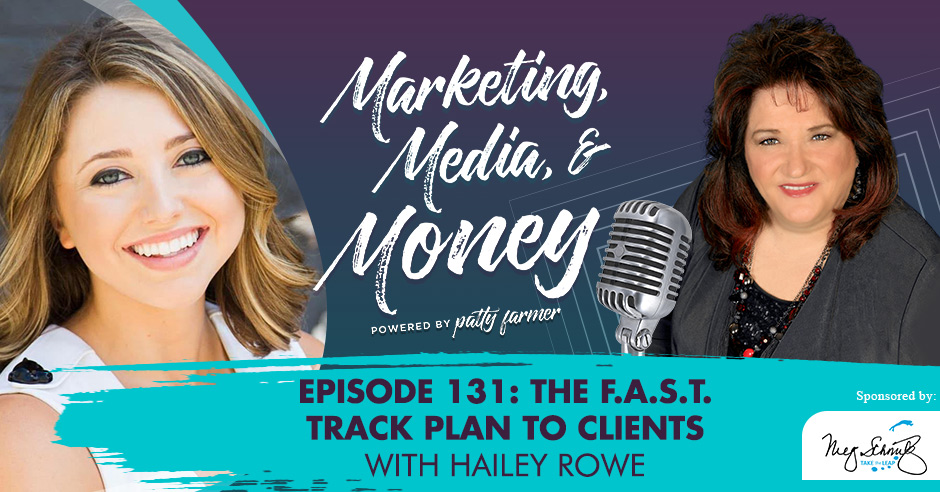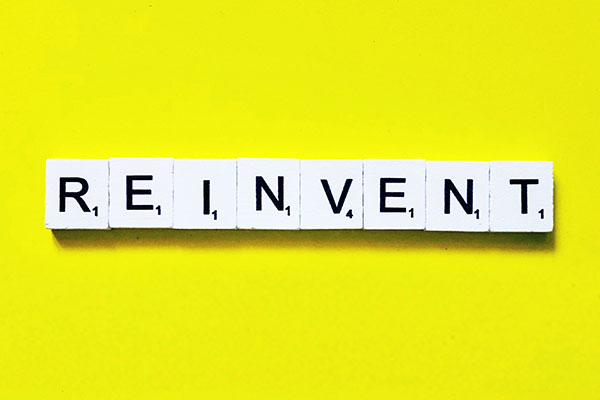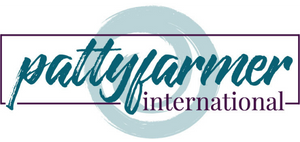Want to know the 7 key areas
needed to ramp up your business?

The F.A.S.T. Track Plan to Clients with Hailey Rowe (Episode 131)

Have you ever wondered why, despite posting online every day, your audience doesn’t really seem to go and sales don’t really seem to happen? Do you want to stand out online and actually create demand for your services? Then you’re in the right place! In this episode, Hailey Rowe talks about how posting every day might actually be costing you sales. Hailey shares how you can start ditching the “shiny object syndrome” and get focused on the client-generating activities! So what are you waiting for? Ditch the self-doubt… No more Imposter Syndrome, All or Nothing Mentality, or Shiny Object Syndrome! Tune in now!
THIS ROADMAP WILL HELP YOU:
Master consistent content creation.
Learn a step-by-step process for time-saving content batching.
Create content that drives DEMAND
Get clarity on the types of posts & ways to structure posts to get more discovery calls & clients
Gift: Free Content Roadmap: Streamline 30 days of content that drives sales: https://haileyrowe.kartra.com/page/CONTENT
Connect with Hailey Rowe!: Website | Linkedin | Facebook | Twitter | Instagram
Click on the icon to listen to this episode on your favorite podcast platform.
The best time to fail publicly is when you're at the beginning of your business, when nobody's really paying that much attention to you. Share on X
Treat people like clients even before they are clients. Give love, don’t hold back, and do what other people aren’t willing to do, such as giving the tools and value of what you offer. Share on X
The Nine Word Email by Dean Jackson helps you reengage with your social media audience or email list that’s been dead or not very responsive. Share on X
Hailey’s Free Gift: Free Content Roadmap
Hailey’s #1 Marketing, Media & Money Strategy
DID YOU LIKE THIS EPISODE? PLEASE GIVE IT A RATING AND REVIEW
About Hailey Rowe
 Hailey Rowe is a Marketing & Sales Coach, as well as a Linkedin Lead Generation Service Provider.
Hailey Rowe is a Marketing & Sales Coach, as well as a Linkedin Lead Generation Service Provider.
She helps online entrepreneurs, especially health & life coaches, get clients consistently, develop their no brainer offers, & grow their income & impact. She shares her F.A.S.T. framework, marketing, and business tips in her Health Coach Nation Podcast & in the Health Coach Nation Facebook Group.
She’s been named as one of the Top 25 Coaches in Chicago & one of the Top 6 business podcasts for health coaches. Since 2010, Hailey has worked in the coaching industry & in business development/marketing for startups. Hailey’s philosophy: You can have an amazing service and impact to make, but without a strong mindset, and sales and marketing plan, your business will remain a hobby.
Resources and Important Links
Grab Your Free Marketing, Media, & Money Assessment
Meet Our Sponsor
The Marketing, Media, & Money Podcast (and magazine) would like to thank our sponsor Meg Schmitz, founder of Take the Leap franchise consulting company.
The franchise industry is booming as people look to diversify their income streams with essential businesses, without having to quit their day job. If you have ever considered what it would be like to own your own business with the security of a solid brand behind you, schedule a call with Meg. The conversation is free, and the insights are priceless. https://MegSchmitz.com
The F.A.S.T. Track Plan To Clients With Hailey Rowe
I’m looking forward to sharing this episode’s industry expert with you. I’m excited because, in this episode, I’m bringing on a marketing expert. We are going to be talking a little bit about some myths, what’s going on, Shiny Object syndrome, why you haven’t been able to book some of those discovery calls, and more importantly, why you haven’t been able to close them. We’re going to go over a few strategies that you may want to make sure that you have a pen and paper so you can be writing them down.
Let me tell you a little bit about our guest. Hailey Rowe is a marketing and sales coach as well as the podcast host of the Health Coach Nation podcast and a LinkedIn lead generation service provider. She’s been named one of the Top 25 Coaches in Chicago and one of the Top 6 Business Podcasts for Health Coaches. Since 2010, Hailey has worked in the coaching industry and business development marketing for startups. I love that because we all know that startups have a lot of things they need to be working on, and then it gets better and better. We’re going to talk about that. Hailey, thank you so much for being here with me.
Thank you. I’m excited to be here, Patty.
I love that you are very specific about the niche that you want to work in. A lot of times in a lot of industries, and we talk about this all the time, everybody thinks that they are the person for everybody. While sometimes that is true where you can pretty much work with a lot of people, I prefer to work with industries that bring me joy and make me happy. I love that you have found that space for yourself. That is a fabulous thing. Let’s dig in and get into it.
The first thing I always like to say is I like to know what not to do, just as much as I like knowing what to do. What would you say are a few myths that people have about marketing? I’ll go first and throw something out there. A lot of times, people get marketing funnels confused with sales funnels. They’re not the same thing. That’s a myth. For you, since you work with startups, what are some of the myths that you hear over and over again?
There are quite a few. Number one, a lot of people think the very first step is you need a very fancy website to get started. You want to make sure you know your audience and how they speak about their needs. Also, what your offer is, or what problem you solve before you go all in on making this website, putting so much into it, and writing all the copy. If you put out a website and then you find out that nobody has this problem or nobody wants this and I haven’t sold anything yet, it’s not the best idea to have that all done and have to redo it. That’s a major one.

F.A.S.T. Track Plan: Make sure you really know your audience, how they speak about their needs, and what value or solution you can offer for them before you go all-in on making a website, putting so much into it, and writing all the copy.
A lot of times, people think they need to do ads or something as a first step. I know you and I agree that it’s all about building relationships first and booking clients from those relationships so that you know what works and what people respond to. You could then go and say, “I want to put some ads behind this.” The last thing, too, is going back to your thing about niching. A lot of times, people are afraid to do that because they think they’re going to be pigeonholing themselves or feel like nobody’s going to come to them if they’re too specific.
The truth is, if you are trying to be vague, it costs you so much more in client acquisition because you’re not sticking with anyone. You’re not being memorable to anybody. When you go on a dating app and put in or you filled out one of those personality forms and they match you to somebody who matches you, it’s going to be such a much stronger connection and somebody you want to go on a date with than somebody who’s a general, “Here’s a male, and you’re a female. Here’s your match.” There’s no pull there. It’s key to have a clear niche and a clear problem you solve. Don’t be afraid to go all in on it. Those are some of the common mistakes I see.
I agree with you 100%. I’ve been in the marketing and media space for many years, but I know that in the beginning, one of the things that I figured out that I liked early on was this. I wasn’t sure if I was ready to come out and say it like this sweeping statement, but I realized that I have six daughters and I come from a family of four girls. I love women.
I decided that I wanted to literally come out and say, “I like to work with women. I market to women, and the right men show up.” It’s not that I don’t have male clients, but they’re the right male clients. At least 95% of my clients are women, and I love that. One time, I said it and somebody got upset and said, “Really, Patty? You’re going to pick clients based on their genitalia?” I was like, “No. I’m only saying that this is what I prefer because I understand them. I get them. I love the drama, the hormone, and the whole thing about women. I get it, and I love it. It’s super easy for me and comfortable. I like it.”
When I decided to do that, it felt so good once I said it. I have a lot of men that say, “I serve women. I run a women-owned company,” or whatever the case may be. Great, then you are my kind of client. People want to know that. It establishes credibility and authority even in a way that people know that you’ve done it not just one off time where somebody might say, “Have you ever worked with somebody that did this,” and maybe you did one time. People want to know that. I like those answers.
Specializing allows you to have a more premium product. If I said health coaching or whatever service for everybody, it’s a commodity, and I’m going to compare it to everybody else. If you’re like, “Health coaching for a specific type of person who wants to do a specific type of goal,” suddenly it becomes way more valuable because you’re specializing in something that you’ve created proven results time and time again for a specific type of person. They’re going, “This gal or this guy gets me.” It helps you separate yourself from the pack. We want to go to somebody who specializes and is the best in something compared to a commodity.

F.A.S.T. Track Plan: Specializing allows you to have a more premium product.
I agree with you. Let’s face it. If you are in business and you’re not an expert at what you do, get a job. That’s the reality. When I’m writing a check, I don’t want an expert. I’m assuming that anybody who owns their business and has been in business for more than a year or two are an expert. However, that’s not what I’m looking for. Where I am, I hire people who are going to take me to the next level. I want somebody who’s an authority, not only an expert.
I’m looking at those and not only what they’re saying but what are they doing. Also, what you said about the website, in the beginning, it may be fluid because you don’t know, but once you specialize, now I want to see it on your website. I want to see it through your social media posts. I want to hear it when you’re speaking. All of that needs to come together for me and then I feel comfortable.
A lot of times, people are doing spaghetti marketing where they throw stuff at the wall and hope it sticks. I call it lazy marketing. There are a lot of things I don’t know about other things that aren’t what I do. I want to hire somebody that is an expert at that. People should for you. If health and wellness are what you do, there are tens of thousands of people, but when you specialize down, as you said, your people are raising their hand and saying, “Yes, you’re exactly the person that I’m looking for, and I’ll pay you premium dollars for that because I know you’ve done it over and over again. Also, I’m probably going to get better results than somebody who has done it once.”
That makes a lot of sense. Another thing that you mentioned was about paid ads. That’s interesting because I believe that a lot of people think that’s the magic bullet. “Let me throw some money at it.” In life, in general, if you have a problem that could be solved by throwing money at it, it’s probably not a problem. A lot of times, people do that. They don’t know who they serve and how they want to serve them.
They’re like, “If I take out an ad and pay some money, magically, whether it’s YouTube, LinkedIn, Facebook, or whatever, that’s going to get me clients.” I don’t believe that to be true. Also, you don’t believe that to be true. Although, we would both agree there are times when it can jumpstart something if you have other things in place first. It’s not the end-all-be-all. It’s one tool in a tool belt of strategy.
One of the things I know that you are known for is talking about this roadmap you have in talking about content. Let’s talk about that. I love something that I read about you that said that you believe that posting every day might be costing you sales. That’s a powerful statement, Hailey. It’s also a statement I love. Let’s talk about that. Why do you believe, and what’s a strategy around that you came up with that? Why do you think posting every day might be costing you sales? Are you talking about social all across the board? Are you talking about specific ones? I know that you are a LinkedIn lead generation service provider, but are you specifically talking about LinkedIn?
The reason why I bring that up is that a lot of times, when you’re a new business owner or business owner in general, you have a lot on your plate. A lot of times, it’s easy to get sucked into things you think you need to be doing because you need to be doing it compared to what’s going to get you clients. A lot of times, people think that posting more is the key to getting more clients. “If I posted consistently, then suddenly, all the people are going to come to me, and they’re going to want my services.”
The truth is, you want to be taking it one step beyond content which is engaging with your audience and understanding them, and offering to help them. A lot of times, that happens on a one-on-one basis or in a webinar setting, or on your email list. My suggestion is, when you’re going to be posting, don’t post just to post, which is what a lot of people do. Instead, be intentional with your posting and have calls to action to either engage with you, join your email list, or book a call with you, but don’t expect the post to be the thing that causes people to sign up all the time.
You also have to be welcoming. For example, your new Facebook group members where you’re saying, “Thanks for joining the group. I noticed you joined. I realize you’re a human being here.” You don’t obviously say that, but send a message or something. Welcome them and see if you get to know them a little better. Ask them what they want to see in the group, and then you could customize the content towards what they need, or you can offer to help them with your freebie or whatever it is.
My whole thing about why you shouldn’t be posting every single day if you have a limited amount of time is because your energy might be better spent engaging privately with these people or in a more intentional way, like in a webinar or something like that. You can use content to funnel people to those things, but it’s not the be-all-end-all.
Let’s talk about repurposing because if you’re not posting every day, it doesn’t mean you can’t be taking the content that you have and chunking it or batching it. There are a lot of different ways to do that, and I believe the key is knowing how to use everything you do more than one way. I’m a speaker. I tape all my speeches and chunk them all down. I think of how I can be using them in content for social, blogs, or an article, or how else can I be using them.
That is a really good way to do it. This is where I want to get your feedback. I love it when I have marketing people because it’s a different perspective, and my audience likes that. We all love different perspectives. For me, I also think about where they are in the customer journey. One of the mistakes that I feel that I see often is that everybody is trying to talk to everybody no matter where they are in the customer journey at the same time in the same post.
We do know that we need to talk to them all, but I don’t believe in the same post. We need to be specific and intentional. Intentional is one of my favorite words. Who are you talking to in this post? I want to hear your perspective and insights. When you’re repurposing content, you get the ability to do. You may have this one piece of content that now you can chunk down and batch in different ways so that you can tweak it to who exactly you are speaking to, but it was the same content, to begin with. What’s your perspective and your insights on that?
I totally agree. I’m a big fan of repurposing content. We often spend so much time reinventing each post. People need to hear the same thing 7 to 17 times before it registers. Only because you posted something two days ago on Facebook doesn’t mean everybody on all your other social media platforms saw it or even your people on that platform saw it. Only on a business page, if you’re not using ads on Facebook, 6% of people will see your post.

F.A.S.T. Track Plan: So often we spend so much time reinventing each post, but the thing is people need to hear the same thing 7 to 17 times before it really registers. Just because you posted something two days ago on Facebook doesn't mean everybody on all your other social media platforms saw it.
The key is to realize that nobody’s paying that much attention to you, unfortunately. Let’s say you did a video and created a transcript for that video so now you can pull some quotes from it to do quote graphic posts. Maybe you took a clip of the video to make it an Instagram reel. It’s a part that’s juicy and gives a great tip. Maybe you make another video of yourself talking about that video and enhancing it with a little bit or an add-on point you wanted to make.
There are a lot of different ways you can repurpose. I heard this great tip from The TikTok Coach. Her name’s Samantha Vlasceanu. She said you could take one idea you had where you turn it into eight pieces of content. One idea would be, “Three myths when it comes to,” and then insert something in your industry or your business. One day, you might share the three myths and a quick overview of them. Another day, you might break down each one as its own day’s post and go into a lot more detail about it.
Another day, you might talk about why those three things matter. That would be another three days of posts going into the why of it. On another day, you might go into the story about why those things don’t work or why those are myths. That would be three separate posts. You could space these out. You don’t want to do this all back to back.
There was one other type. The story, the how, the why, and the strategy. The point is, you can take milk one thing for all it’s worth. We need to do more of that in our business because otherwise, we’re always off to the next shiny object and reinventing something without getting full capacity and use out of what we’ve already created.

F.A.S.T. Track Plan: So often, we're always just off to the next shiny object and reinventing something without getting full capacity and use out of what we've already created.
I don’t know if you know her, but on Instagram is Mel Robbins. She is the queen of the carousel. I mean that whole, “Swipe here, swipe here,” and she’s able to take 3, 5, and 7 points. You’ll swipe and she’ll have each one on a separate one. The last one is the one where she ties them all together with a nice pretty bow and says something. When she does that, once you swipe once or twice, now you have to swipe all the way to the end because you want it to be all tied into the pretty little bow.
Every time I see it, I think, “What a great strategy.” She talks about all kinds of different stuff. It’s not even she has this one niche and if you care about it, that’s the thing. She applies it to a multitude of things, but you always recognize it. There’s always a flow and branding thing because she always highlights those in yellow. As soon as you see it, you know it’s hers because she’s branded them.
That is brilliant. If somebody didn’t want to do a lot of videos, and I know there are a lot of people out there, “I don’t love doing videos,” there are a lot of ways to do a voiceover. There are a lot of ways to do carousels and all kinds of different things so you don’t have to do that. I’m a firm believer that whenever somebody has resistance, think of it like a muscle. Whatever exercise you don’t want to do with that muscle, there’s another exercise you can do to work that muscle. You only have to find the one.
For me, people get surprised that I’ve been in marketing for as long as I have, but I made the decision that I don’t like to blog. I didn’t like the consistency of having to do it with all the things I did in my business. A few years ago, I said, “This doesn’t make me happy. It’s a stressor for me. I’m going to stop blogging.” I decided I’m going to stop blogging. Instead, I published a magazine. Now, I only have to write it once a quarter, and it works for me.
There are a lot of different ways that people could do different things. Consistency and relevancy are key, but Matthew Hunt says that B-plus content delivered with A-plus consistency will outperform A-plus content delivered with B-plus consistency. When you’re thinking about it, it goes back to that done not a perfect thing that we all can get hung up on.
The reality is if you’re speaking from your heart, people know you’re speaking from your heart, and that’s what they want. That’s how you’re going to have that human connection. I know that you say that you work within this Imposter syndrome. Because there’s so much on social and people see all this, do you think that those are some of the things that get people into the Imposter syndrome thing?
I work with a lot of people who come to me and say, “I feel like I’m not enough. I feel like my content’s not good enough. Who would want to listen to me when there are all these other people?” They’re comparing themselves to somebody else who’s been in business for 25 years, and they’ve only been in business for five years or something. They’re totally unfairly comparing themselves to somebody else.
Doing the actual act of posting content, having a consult call, or making an offer isn’t hard. What makes it hard is your thoughts about all of that, “Should I do the post? Is the graphic good enough? Are people going to think this is weird?” That’s all the stuff that drains you, and it’s carrying a little heavy sled behind you while you’re trying to get your work done.
Going back to what you said about B-plus work, I love that concept. You have to become okay with B-plus work sometimes and know that done is better than perfect. The only way you’re going to get better is if that’s what you’re concerned about. Usually, if you have Imposter syndrome, it’s because you want to be better. You want to be the best. If you want to be the best, you have to be willing to fail and figure out what works. Be vulnerable and put yourself in harm’s way to find out how to be better the next time. You don’t get to skip that part. You don’t get to magically turn into perfect one day. You have to be failing publicly. The best time to fail publicly is when you’re at the beginning of your business and when nobody’s paying that much attention to you.
I remember when I first started blogging before I realized that I didn’t like it. When I was first doing it, it was a stressor from the very beginning. Everybody said, “That’s what you have to do.” My coach finally said to me one day, “Patty, you need to get over yourself because your first 50 blogs are going to suck anyway. The only way you’re going to get better is to do it. If you’re doing it to get better and you’re finding that you don’t like it and every day is the last thing that you do, then don’t do it.”
When you hear people on social talking about, “You need to be on every single platform and you need to do every single strategy,” that is not true. If I had $1 for every time somebody said to me, “Patty, do I need to be on every social media platform? What social media platform should I be on?” I always say, “Here’s the simple answer. You should be on the social media platforms where your ideal clients hang out. That’s where you should be.”
That’s the name of the game. You should be where your people are. The first thing is always, “Who are my people?” What you got to focus on in the beginning exactly who are your people. That is important. There’s another thing that you said that I liked when you were talking about the posting and how to structure those that people don’t realize. Let’s talk about calls to action.
One of the things that I have found is if in the customer journey, they’re only beginning and getting aware of that, trying to talk to them and trying to close this $5,000 sale isn’t even smart. They’re not there. They’re only becoming aware that they have that problem, but then, maybe somebody is aware and they’re interested. They’re literally at the stage where they’re evaluating, “I’m going to do something about this. I need to solve this problem, but who should I hire to solve that problem?”
Maybe that is the time. What I notice a lot lately, especially on LinkedIn, everybody wants to hammer every single thing. They’ll post something, and it will be valuable. It’s got some great stuff in it. After that, they want to say, “Let’s do this, buy this, or do that.” There’s a time for that. It’s always been inviting them to take the next step. I even believe in sales that you’re doing somebody a disservice if they like your stuff and you don’t give them an opportunity to take the next step. Invite them to that. They can say no.
I also believe that there are certain calls to action that work better with certain things. A huge part of my audience offers discovery calls, breakthrough sessions, strategy sessions, or whatever somebody’s verbiage is for that. It is probably the way that I get most of my clients, but there’s almost an art to knowing when the right time is. This isn’t, “Let’s connect and get on a call.” I don’t want to be having coffee with 100 people. There’s an art to knowing when that should be the call to action versus, “Here’s my free downloadable XYZ.” Let’s talk about discovery calls.
When it comes to getting discovery calls, the key is you have to understand you’re taking somebody’s time when you have a discovery call. You have to almost sell the call as very valuable and almost like a paid program because if you say, “Let’s connect for a coffee chat,” what’s in it if I’m reading that as your audience? I’m going to ask, “What’s in it for me? Why do I care? Why should I set aside time in my day to talk with you?”

F.A.S.T. Track Plan: When it comes to getting discovery calls, the key is you have to understand you're taking somebody's time when you have a discovery call.
When you’re doing posts, I do what I call pre-offers. What I mean by pre-offers is you want to have your audience raise their hand and indicate that they’re interested in some way, shape, or form by asking a very directed question that can lead to a discovery call where you’re going to share the answer or it can lead to a discovery call and you’re going to go deeper on whatever the question was.
Let’s say you, Patty, work with service providers. I’m going to talk about the difference between a discovery call and an intro call, but I’m going to talk about why if you’re newer, it can lead to why you need to have both going on. In other words, you might say, “This week only, I’m offering ten free offer audits for service providers who want to increase the price of their offer without objections,” or something like that. “The first ten people to comment will get one of these audits.”
That audit would be something where you wouldn’t be doing it as a full discovery call. It would be a short 15 to 20 minutes thing where you’re in front of your person, which is a valuable use of your time, especially if you’re new and you’re starting out. You need to get in front of those people and give them some value. Patty, maybe you had a pre-recorded thing you could send everybody to, and then on that, you sell a discovery call if you didn’t want to do this one-on-one.
You would share some tips with them, and then you’d be like, “To get this fully done or to get more support with this stuff, is there anything you’re looking for help with? Do you have any goals you’re working on?” You can then see if they’re interested in more of a deeper call. Maybe they’re not, and that’s fine. You’re going to deepen and more quickly accelerate that relationship so much more by doing that post than if you were to say, “Join my Facebook group,” on your call to action, which there’s a time and place for other calls to action too.
You don’t want every single post to be, “I’m doing a call again,” but that would be one way to switch it up where you’re not always saying, “Book your free strategy consult.” You’re giving it a theme or giving it a tangible thing they’re going to get of why they should come to this call with you and that could be great. The other way you could go about it if you wanted it to be a discovery call is where in the post itself, you’re talking about a piece of the whole cake of your program.
You’re saying, “This is one part of my five-step process to this and that. If you’re interested in learning my framework, to do that and how it can apply to your business, grab your consult now.” It’s more direct, and people know what they’re signing up for. Those leads are going to be warmer, but you’re going to get less of them than that free audit type of post.
The key for everybody reading is to balance out. Sometimes, you’re going to do those intro call types of things where you’re giving some value and selling that cool call with your opportunity. Sometimes you’re going to be doing it as a discovery call, but you’ve already illustrated in your post why it’s important and who it’s important for.
A lot of times, when I see posts that every single time they’re saying the same thing, one of the things that are important for people to remember is that we live in a world where people know, “We get it. We know.” If they want to find you or they want to do something, they know how to go to your website. They know that you’ve got everything on your website. Your social is on there. Whatever opt-in you’re talking about on LinkedIn, it’s probably on your website.
Sometimes the key is to provide value, not everything. For myself, I tend to only have every 3rd to 5th thing that I do have a call to action. I try to give value. I can’t even tell you how many people have found me and said, “I saw you did this or that, and that’s what made me reach out to you.” It then leads me to the next thing, but we’re going to tie it back. Wouldn’t you say or agree that it’s hard to quantify likes, shares, and all of that stuff on social? You have to know that.
I find that the people who usually hire me were not engaging in my posts at all until after they hired me. Some people like to stalk. They watch and be quiet. Part of that is because now, when people engage, they’re so worried that then you’re going to hit them up and say, “You talked about this on my post. Let’s get on a call.” They only thought what you said was interesting.
People should pay a little bit more attention to that. I would much rather have somebody comment on my post and add more value and talk about insight and a different perspective so we can have a conversation that will give more value rather than somebody to get on my post to say, “Bam,” or #Truth or something like that. I know that feeds the algorithm a little bit, but the reality is, what is it that you’re trying to do?
When you create urgency for what you were sharing in those, which was creating urgency, saying, “I only have ten or I only have this and now this.” Now, you’ve created value for them that, “You give this great information, and now you’re going to get on the call. I want to be one of those ten people.” What you’re saying there has much validity to that because I believe that even the word discovery call now, people see that as a disguise for a sales call. They’re like, “You’re telling me that you’re going to help me with this,” which means that you’re going to get on a call and pitch. For me, one of the ways that I like to stand in integrity is when I do offer those in the way that you said. I always say that it’s a pitch-free call.
They then feel comfortable. Here’s one of the things that’s funny, and I’m sure this has happened to you too. By the time you do have that call, they’re like, “What would it look like to work with you?” I told you this was a pitch-free call. They’re like, “I know, Patty, but we’re already on the call.” Stay in integrity with what you’re saying. What do you think about that?
It is a much smoother transition. When you’ve given results ahead of time or wins on a little call or in your posts and stuff, it is a much smoother and natural transition to talk about how you can continue together. One of my favorite principles is to treat people like clients before their clients, giving them value and not holding back and doing what other people aren’t willing to do, which is giving the tools, giving value, and not being like, “I need this to come back to me in this way.”
You’ve nailed that. Also, you don’t want to have a bait-and-switch type of thing. If you are currently taking applicants for your program and you’re in a launch period, say that. Don’t be like, “This call is a free call for no purpose,” if that’s not what phase you’re in right now in your marketing. I do think that’s important. Separating the two different types of calls is important.
I also want to point out that there are silent audiences and all that stuff. The people who usually buy from you are usually not content consumers all day. The people who pay for your program are busy people who are like, “I want to solve this problem,” and they’re not sitting around on social media all day liking and engaging and stuff, which is usually what I’ve found.
Don’t be discouraged if you don’t have a ton of likes and don’t have a lot of engagement. Know that there are those silent viewers. One thing I like to say, too, is the value you put out, it might not always come back to you the way you think it’s going to come back to you, but it will come back to you in some way, shape, or form. Whatever you’re putting out now, even though you feel like, “Nobody’s liking this,” it’s getting added to your vaults or whatever, and it’s going to accumulate.
As a matter of fact, the last client that hired me reached out to me on LinkedIn and said that she had heard me speak a few years ago. She said that she was watching my content, but she didn’t engage. She said she wasn’t ready. She said, “Patty, when I remember somebody’s first name and last name and that I heard you speak a few years ago, I knew we were going to work together. I was waiting for the right time.” You never know.
Sometimes people think too short-term, but that was a golden nugget. What Hailey said about that nugget about treating people like clients before their clients is a gold nugget, and I hope everybody wrote that down because that is super important. Not everybody always get that they’re running around also busy and stuff, but people are watching. Just because they’re not engaging doesn’t mean they’re not watching.
People should think about that human connection, who it is, who your audience is, and make sure that you’re showing up. That is important. You could have all this great value and all these great amazing stop-the-scroll graphics and all this wonderful content, but if your call to action leads to something ucky that makes them not feel good, you did all that for nothing.
I know that we’ve touched on some great things here like Imposter syndrome, discovery calls, how to batch, and what kind of content you should do. That’s a lot of things rather than focusing on one super thing. I love the idea of having another marketing person because the conversation is always so good when you have different things. Hailey, how can people get ahold of you? I know that they’re going to want to connect with you. What’s the best way to do that?
Thank you so much. My website is HaileyRowe.com. On top of there, there’s free niche marketing training if you’re looking to get clear on your elevator pitch. I also have a Free Content Roadmap for your audience that’s going to take you through that process that we talked about which is helping you structure your posts better, helping you streamline, create 30 days of content that will be compelling to your audience, and more intentional rather than busy work. I do want to recommend that to everybody reading.
I love it when guests come to my show and have a gift. Thank you so much. I appreciate that. We’re getting to that point where we’re getting ready to wrap up. You’ve already given us such great content. Thank you so much for being so generous with your brilliance. It is tough when you’re asking a marketing person. What’s your number one marketing, media, and money strategy?
The one I wanted to bring to the show is the nine-word email created by a famous marketer, Dean Jackson. How it works is if you have an email list or even if you have a social media audience that’s been dead or not responsive, this is something that you can do to get them re-engaged. When you’re engaged with people, conversations are where it all starts.
The whole way you want to do this is you want to think about what is a question could relate to the problem you solve or the offer that you have. The way you’re going to do this is non-pitchy and plain text. It’s not going to be in a newsletter format. You’re not going to add photos. It’s going to be very simple. Step one is to think about what your question’s going to be. For example, for someone like Patty, it might be, “Are you looking to take on new clients as a service provider?” or, “Are you currently looking to launch your,” insert whatever it is they want to launch.
It would be something where they could give you a yes or no answer, and it should also be something that’s not too embarrassing for them to answer. It should be something that could lead to you either providing some kind of free resource to help them with whatever they said they wanted or offer that free audit call or seeing if it does make sense to have a deeper chat. That’s step one is thinking of your question.
Step two is to give it a good subject line. You want to use something like, “Question, first name,” or, “Hey, first name.” It’s something not super detailed just to generate some curiosity to open the email. In the email, you’d have that plain text of, “Hey, name,” and then insert your question. That’s it. The reason why this works is because people don’t have to read this long thing. It’s simple. It’s a yes or no. You get to know where your audience stands in the problem that you solve, and it can generate some conversations.
That works. Sometimes people think of the days of the long robust newsletter and stuff. What happens is people look at that and say, “This is so juicy and so good. I’m going to save it over here. I’m going to come back and read it,” in which case they don’t. It’s not because they’re not interested. They’re just busy. Do a 9-word, maybe 12, but a very short yes-no question. You’re asking me if I have that problem, and if I do and you touched a nerve or you spoke directly to me, I’m going to be like, “Yes, I am having that problem.”
I’m going to hit reply and say, “Yes. As a matter of fact, I am having that problem.” It’s something very easy that people can respond to right now. It’s a great way to reengage past clients that you haven’t heard from or maybe people that were in a group of some sort. Maybe you did a challenge or some type of thing, but you want to reengage.
That is a good first step to a nurture sequence where you know now you’re doing some other thing, but it’s a good way to open the lines of communication. Hailey, it was a great tip. You gave some great information, good insights, and perspective. I appreciate that so much. Thank you for being on the show with me.
Thank you. This was a blast. I love jamming with you.
Thank you to the audience. I know that this is a multi-topic day where we talked about a lot of different things. Make sure you connect to Hailey. Make sure that you grab that gift because that’s a great gift. I’d like to talk about taking action. You might want to be thinking about that nine-word email. It might be a great thing too. I have to take a moment to thank our sponsor. The show is sponsored by Meg Schmitz, the Founder of Take the Leap Franchise Consulting Company.
The franchise industry is booming as people look to diversify their income streams with essential businesses without having to quit their day job. To learn more, schedule a call. Go to www.MegSchmitz.com. The conversation is free, but the insights are priceless. Thank you again for joining us. We will speak to you again next episode. Until then, have a phenomenal day.
